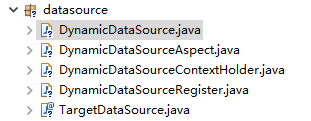Springbooot 配置資料庫多資料來源
前言
在實際專案中,我們可能會碰到在一個專案中會訪問多個數據庫的情況。針對這種情況,我們就需要配置動態的資料來源了。一般按照以下步驟即可
一、在啟動類上添加註解

二、在application.properties檔案中
#預設資料來源
spring.datasource.driver-class-name= com.mysql.jdbc.Driver
spring.datasource.url = jdbc:mysql://127.0.0.1:3306/tianxi_mall?useUnicode=true&characterEncoding=UTF8&serverTimezone=GMT%2B8&allowMultiQueries=true
spring.datasource.username = root
spring.datasource.password =
#其他資料來源.sqlserver
custom.datasource.names = ds1
custom.datasource.ds1.driver-class-name = com.mysql.jdbc.Driver
custom.datasource.ds1.url = jdbc:mysql://192.168.2.2:3306/wechat?useUnicode=true&characterEncoding=UTF8&serverTimezone=GMT%2B8&allowMultiQueries=true
custom.datasource.ds1.username = root
custom.datasource.ds1.password =
注:假如其他的資料來源不是mysql,請自行百度其他資料的連線驅動
三、配置

import org.springframework.jdbc.datasource.lookup.AbstractRoutingDataSource;
/**
* AbstractRoutingDataSource獲取資料來源之前會先呼叫determineCurrentLookupKey方法查詢當前的lookupKey,這個lookupKey就是資料來源標識。
因此通過重寫這個查詢資料來源標識的方法就可以讓spring切換到指定的資料來源了
* @author mayn
*
*/
public class DynamicDataSource extends AbstractRoutingDataSource{
protected Object determineCurrentLookupKey() {
//從自定義位置獲取資料來源標識
return DynamicDataSourceContextHolder.getDataSourceType();
}
}
import org.aspectj.lang.JoinPoint;
import org.aspectj.lang.annotation.After;
import org.aspectj.lang.annotation.Aspect;
import org.aspectj.lang.annotation.Before;
import org.slf4j.Logger;
import org.slf4j.LoggerFactory;
import org.springframework.core.annotation.Order;
import org.springframework.stereotype.Component;
/**
* // 保證該AOP在@Transactional之前執行
* @author mayn
*
*/
@Component
@Aspect
@Order(-1)
public class DynamicDataSourceAspect {
private static final Logger logger = LoggerFactory.getLogger(DynamicDataSourceAspect.class);
@Before("@annotation(ds)")
public void changeDataSource(JoinPoint point, TargetDataSource ds) throws Throwable {
String dsId = ds.name();
if (!DynamicDataSourceContextHolder.containsDataSource(dsId)) {
logger.error("資料來源[{}]不存在,使用預設資料來源 > {}", ds.name(), point.getSignature());
} else {
logger.debug("Use DataSource : {} > {}", ds.name(), point.getSignature());
DynamicDataSourceContextHolder.setDataSourceType(ds.name());
}
}
@After("@annotation(ds)")
public void restoreDataSource(JoinPoint point, TargetDataSource ds) {
logger.debug("Revert DataSource : {} > {}", ds.name(), point.getSignature());
DynamicDataSourceContextHolder.clearDataSourceType();
}
}
import java.util.ArrayList;
import java.util.List;
/**
* 用於持有當前執行緒中使用的資料來源標識
* @author mayn
*
*/
public class DynamicDataSourceContextHolder {
private static final ThreadLocal<String> contextHolder = new ThreadLocal<String>();
public static List<String> dataSourceIds = new ArrayList<>();
public static void setDataSourceType(String dataSourceType) {
contextHolder.set(dataSourceType);
}
public static String getDataSourceType() {
return contextHolder.get();
}
public static void clearDataSourceType() {
contextHolder.remove();
}
/** * 判斷指定DataSrouce當前是否存在 * */
public static boolean containsDataSource(String dataSourceId){
return dataSourceIds.contains(dataSourceId);
}
}
import java.util.HashMap;
import java.util.Map;
import javax.sql.DataSource;
import org.slf4j.Logger;
import org.slf4j.LoggerFactory;
import org.springframework.beans.MutablePropertyValues;
import org.springframework.beans.PropertyValues;
import org.springframework.beans.factory.support.BeanDefinitionRegistry;
import org.springframework.beans.factory.support.GenericBeanDefinition;
import org.springframework.boot.autoconfigure.jdbc.DataSourceBuilder;
import org.springframework.boot.bind.RelaxedDataBinder;
import org.springframework.boot.bind.RelaxedPropertyResolver;
import org.springframework.context.EnvironmentAware;
import org.springframework.context.annotation.ImportBeanDefinitionRegistrar;
import org.springframework.core.convert.ConversionService;
import org.springframework.core.convert.support.DefaultConversionService;
import org.springframework.core.env.Environment;
import org.springframework.core.type.AnnotationMetadata;
public class DynamicDataSourceRegister implements ImportBeanDefinitionRegistrar, EnvironmentAware {
private static final Logger logger = LoggerFactory.getLogger(DynamicDataSourceRegister.class);
private ConversionService conversionService = new DefaultConversionService();
private PropertyValues dataSourcePropertyValues;
// 如配置檔案中未指定資料來源型別,使用該預設值
private static final Object DATASOURCE_TYPE_DEFAULT = "org.apache.tomcat.jdbc.pool.DataSource";
// private static final Object DATASOURCE_TYPE_DEFAULT =
// "com.zaxxer.hikari.HikariDataSource";
// 資料來源
private DataSource defaultDataSource;
private Map<String, DataSource> customDataSources = new HashMap<>();
@Override
public void registerBeanDefinitions(AnnotationMetadata importingClassMetadata, BeanDefinitionRegistry registry) {
Map<Object, Object> targetDataSources = new HashMap<Object, Object>();
// 將主資料來源新增到更多資料來源中
targetDataSources.put("dataSource", defaultDataSource);
DynamicDataSourceContextHolder.dataSourceIds.add("dataSource");
// 新增更多資料來源
targetDataSources.putAll(customDataSources);
for (String key : customDataSources.keySet()) {
DynamicDataSourceContextHolder.dataSourceIds.add(key);
}
// 建立DynamicDataSource
GenericBeanDefinition beanDefinition = new GenericBeanDefinition();
beanDefinition.setBeanClass(DynamicDataSource.class);
beanDefinition.setSynthetic(true);
MutablePropertyValues mpv = beanDefinition.getPropertyValues();
mpv.addPropertyValue("defaultTargetDataSource", defaultDataSource);
mpv.addPropertyValue("targetDataSources", targetDataSources);
registry.registerBeanDefinition("dataSource", beanDefinition);
logger.info("Dynamic DataSource Registry");
}
/** * 建立DataSource * * @param type * @param driverClassName * @param url * @param username * @param password * @return * @author SHANHY * @create 2016年1月24日 */
@SuppressWarnings("unchecked")
public DataSource buildDataSource(Map<String, Object> dsMap) {
try {
Object type = dsMap.get("type");
if (type == null)
type = DATASOURCE_TYPE_DEFAULT;// 預設DataSource
Class<? extends DataSource> dataSourceType;
dataSourceType = (Class<? extends DataSource>) Class.forName((String) type);
String driverClassName = dsMap.get("driver-class-name").toString();
String url = dsMap.get("url").toString();
String username = dsMap.get("username").toString();
String password = dsMap.get("password").toString();
DataSourceBuilder factory = DataSourceBuilder.create().driverClassName(driverClassName).url(url)
.username(username).password(password).type(dataSourceType);
return factory.build();
} catch (ClassNotFoundException e) {
e.printStackTrace();
}
return null;
}
/** * 載入多資料來源配置 */
public void setEnvironment(Environment env) {
initDefaultDataSource(env);
initCustomDataSources(env);
}
/** * 初始化主資料來源 * * @author SHANHY * @create 2016年1月24日 */
private void initDefaultDataSource(Environment env) {
// 讀取主資料來源
RelaxedPropertyResolver propertyResolver = new RelaxedPropertyResolver(env, "spring.datasource.");
Map<String, Object> dsMap = new HashMap<>();
dsMap.put("type", propertyResolver.getProperty("type"));
dsMap.put("driver-class-name", propertyResolver.getProperty("driver-class-name"));
dsMap.put("url", propertyResolver.getProperty("url"));
dsMap.put("username", propertyResolver.getProperty("username"));
dsMap.put("password", propertyResolver.getProperty("password"));
defaultDataSource = buildDataSource(dsMap);
dataBinder(defaultDataSource, env);
}
/** * 為DataSource繫結更多資料 * * @param dataSource * @param env * @author SHANHY * @create 2016年1月25日 */
private void dataBinder(DataSource dataSource, Environment env){
RelaxedDataBinder dataBinder = new RelaxedDataBinder(dataSource);
//dataBinder.setValidator(new LocalValidatorFactory().run(this.applicationContext));
dataBinder.setConversionService(conversionService);
dataBinder.setIgnoreNestedProperties(false);//false
dataBinder.setIgnoreInvalidFields(false);//false
dataBinder.setIgnoreUnknownFields(true);//true
if(dataSourcePropertyValues == null){
Map<String, Object> rpr = new RelaxedPropertyResolver(env, "spring.datasource").getSubProperties(".");
Map<String, Object> values = new HashMap<>(rpr);
// 排除已經設定的屬性
values.remove("type");
values.remove("driver-class-name");
values.remove("url");
values.remove("username");
values.remove("password");
dataSourcePropertyValues = new MutablePropertyValues(values);
}
dataBinder.bind(dataSourcePropertyValues);
}
/** * 初始化更多資料來源 * * @author SHANHY * @create 2016年1月24日 */
private void initCustomDataSources(Environment env) {
// 讀取配置檔案獲取更多資料來源,也可以通過defaultDataSource讀取資料庫獲取更多資料來源
RelaxedPropertyResolver propertyResolver = new RelaxedPropertyResolver(env, "custom.datasource.");
String dsPrefixs = propertyResolver.getProperty("names");
for (String dsPrefix : dsPrefixs.split(",")) {// 多個數據源
Map<String, Object> dsMap = propertyResolver.getSubProperties(dsPrefix + ".");
DataSource ds = buildDataSource(dsMap);
customDataSources.put(dsPrefix, ds);
dataBinder(ds, env);
}
}
}
import java.lang.annotation.Documented;
import java.lang.annotation.ElementType;
import java.lang.annotation.Retention;
import java.lang.annotation.RetentionPolicy;
import java.lang.annotation.Target;
/**
* 自定義註解
* @author mayn
*
*/
@Target({ElementType.METHOD, ElementType.TYPE })
@Retention(RetentionPolicy.RUNTIME)
@Documented
public @interface TargetDataSource {
String name();
}
四、配置完成後,只需在要切換資料來源的對映介面上添加註解@TargetDataSource(name="ds1") 即可。注意,ds1是自定義的,對應了配置application.properties中的ds1,如下
/**
* 切換資料來源查詢
*/
@TargetDataSource(name="ds1")
public List<CardInfoResponse> cardInfo(String card_id) {
return cardMapper.cardInfo(card_id);
}
五、至此,完成,親測有效。假如需要拓展更多的資料來源,則相應繼續往下配置即可。
